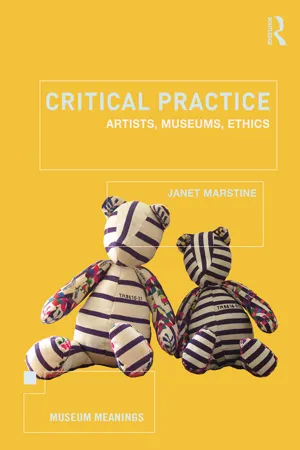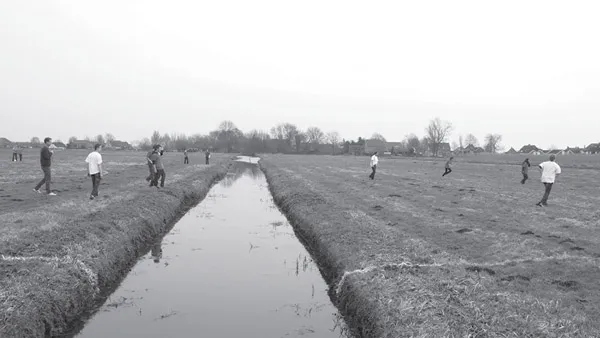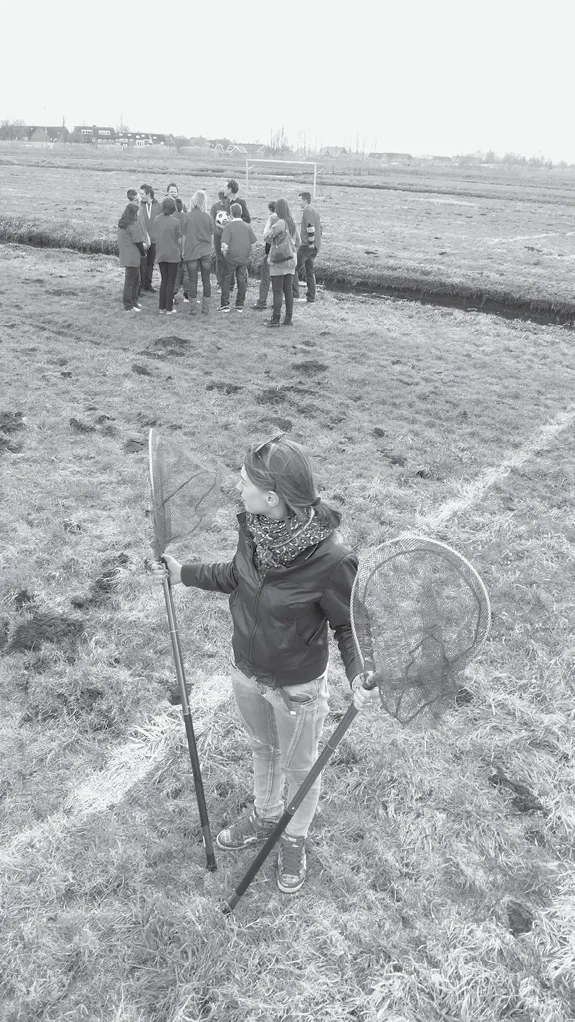![]()
1
Critical practice as reconciliation
The Polder Cup and the Morality project
On 4 September 2010, on a stretch of low-lying land intersected by dykes in Ottoland, South Holland, an unusual series of football games took place. In this landscape, known in the Netherlands as a polder, four football pitches of different sizes were marked out in white (Plate 1). As in a conventional game, flags and goalposts further articulated the boundaries of the fields. Referees stood over the pitches to facilitate fair play. A master of ceremonies read out the schedule of quarter-finals, semi-finals and finals and announced the scores. Each team settled on their own name and shirt design. Fans cheered on the athletes (van Rijn 2011: 16, 18).
As soon as the games commenced, however, it became clear that the dykes criss-crossing the fields made it impossible to follow accepted international football rules; because players were not allowed to jump across the water channels, defenders were unable to reach the opposite side of the pitch (Figure 1.1). This situation challenged teams to generate new strategies of play. And because the pitches were each unique in size and in relation to the dykes, every time a team switched fields, they had to renegotiate these strategies. Over the course of the day, the players devised innovative systems of kayaks, oars and nets to retrieve balls from the water (Figure 1.2). They also recalibrated their steps as they found that the tall grass and muddy ground of the polder prevented quick and graceful movements. The landscape disrupted the game, whilst the game itself disrupted a landscape commonly described as quintessentially Dutch (van Rijn 2011: 16, 18, 20).
This day of football games and its supporting structures is a socially engaged artwork entitled Polder Cup, envisioned by Spanish artist Maider López and commissioned by the Witte de With Center for Contemporary Art in Rotterdam in conjunction with SKOR (Foundation for Art and Public Space). Polder Cup is one of four projects, together called ‘Between You and I’, commissioned by the two organisations to ‘reimagine and renegotiate the limits of public engagement with the institution’ (Gad et al. 2014) through interventions in the façade of the Witte de With. In the case of Polder Cup, López designed a monumental banner that enveloped the façade with a colour photograph of the marked-out pitches, along with text offering details of the project and how to get involved. Like an advertising billboard, the banner recruited the participation of both players and spectators. Interested parties could sign up in the gallery or online. López aimed to draw from both the arts and sports communities.
Figure 1.1 Between You and I – Intervention 3: Morality Exhibition series, Witte de With (Center for Contemporary Art) Polder Cup by Maider López June – September 2010 Courtesy of the artist, SKOR (Stichting Kunst en Openbare Ruimte) and Witte de With (Center for Contemporary Art), image copyright: Bob Goedewaagen
How did Polder Cup reimagine and renegotiate the limits of public engagement with the art gallery? By uniting people who might not ordinarily interact with one another – gallery-goers and football enthusiasts – through group problem solving as play, López demonstrates the potential of artistic practice to strengthen the social agency of museums. Whilst on the surface the teams may only have been collaborating towards a trivial goal – winning a game – the symbolic value of their synergy, as harnessed by the Witte de With, underscores the capacity of art to recognise and advance the penchant of museums for addressing social problems. And by taking the project outside the gallery walls and into the larger public sphere, López creates the conditions for a critique of institutional bureaucracy as rote adherence to rules, not just in the domain of football but also in the world of museums and galleries and in the wider domain of political entanglements.
With its site-specific spatial identity and demands for continual renegotiation among teammates, Polder Cup evokes the convergence between the long Dutch histories of fighting against water and of making decisions through consensus (Gad et al. 2014). The sodden terrain of the polder serves to personify the state; in fact, the bureaucratic insistence on consensus to the point of stagnation in the Netherlands is frequently referred to as the ‘polder model’ (van Rijn 2011: 20). By making it impossible for the footballers to play by accepted rules, López’s project expresses the need for creative, transgressive thinking through dissensus; only through non-conformist resistance to the rules can Polder Cup participants meet success. López planned the tournament to occur at the same time as the 2010 World Cup and to contrast the official game of football with its spectacle of consumption and international rivalries (van Rijn 2011: 18). Polder Cup asks: can resistance against consensus politics open up new solutions to diplomatic stalemates and create opportunities for reconciliation?
Figure 1.2 Between You and I – Intervention 3: Morality Exhibition series, Witte de With (Center for Contemporary Art) Polder Cup by Maider López June – September 2010 Courtesy of the artist, SKOR (Stichting Kunst en Openbare Ruimte) and Witte de With (Center for Contemporary Art), image copyright: Bob Goedewaagen
Polder Cup and the three other projects of ‘Between You and I’ were part of a year-long programme at Witte de With on the theme of ‘Morality’, as conceptualised by then director Nicolaus Schafhausen. Schafhausen commissioned a diverse range of artists’ projects that would engage complex ethical issues from multiple perspectives. As former Witte de With curator Amira Gad (2012) explains, ‘The Morality project came from an idea of wanting to present the grey zones of ethics, to show that ethical decision-making depends on context and time; something can seem right at one point and wrong at another moment’. By demonstrating that ethics concerns much more than following rules but instead entails grappling with the limitations and silences imposed by those rules, Polder Cup aptly embodies the aims of the ‘Morality’ project.
Polder Cup through the lens of critical practice
Interventions
Polder Cup also encapsulates the primary conceptual strands of this book. It is an intervention, a term that, broadly speaking, signifies the act of interceding to create change. In the social arena, for example, a family might stage an intervention to confront a loved one who has a substance abuse problem in the hopes that they will accept treatment. In the cultural sphere an artist might stage an intervention to interrogate the systems and underlying values of an institution, whether a museum, political organisation, educational concern or some other entity, to transform existing conditions. From an art historical perspective, the advent of the intervention is often traced back to twentieth-century movements from Dada to conceptual art and institutional critique (Robins 2013: 47–83). From a museological perspective, the intervention is an artistic strategy that encourages self-reflective museum practice. Over the last few decades many museums and galleries, including the Witte de With, have commissioned artists’ interventions to help these institutions renegotiate their relationship with their publics. At the same time, some artists have come, uninvited, to intervene in museums’ policies, processes and structures of power. In both scenarios artists contribute to a developing discourse about museum ethics.
In the Witte de With intervention that became the Polder Cup, López asks: How do museums, like the institution of football, follow rote rules for conduct without questioning common assumptions? And how are these rules fundamentally undemocratic or underpinned by outdated values and hierarchies that perpetuate inequalities? How does consensus politics in museum and gallery decision-making, like consensus politics in the ‘polder model’ of Dutch democracy, hinder the engagement of diverse stakeholders with revolutionary potential to create change? And how can co-creative practices between museums and their publics, like those of López’s gallery-goers and sports enthusiasts, forge new relationships based on reciprocity? López’s banner across the Witte de With façade both literally and metaphorically frames the ethical questions elicited by the Polder Cup project within the context of the Art Center itself.
Polder Cup is an intervention with ethics at its core. It also represents the growing body of work which I call critical practice, appropriating the term from artist Neil Cummings (2012) to encapsulate the convergences between institutional critique and socially engaged practice. Some of the artists I consider have been pigeonholed as part of the institutional critique ‘camp’ whilst others are typically described as enmeshed in socially engaged artistic practice, but most of them fall somewhere in between, as they have been shaped by both yet have their own distinct approach to practice. For the purposes of this study, these identifiers are not particularly relevant and will be used infrequently, in favour of the term ‘critical practice’.
This book is the first monograph on institutional critique and socially engaged artistic practice informed by current debates in museum ethics. Through international and inter-generational case studies identifying and analysing key themes in critical practice – from collections stewardship to community engagement to the efficacy of democratic forms of governance – the volume demonstrates the capacity of artists’ interventions to advance ethics discourse towards reconciliation between museums and publics. Whilst these are certainly not the only themes of ethically informed discourse emerging from critical practice, they represent particularly significant and fruitful strands for negotiating new relationships. And whilst the study is by no means an encyclopaedic survey or historical account of institutional critique, socially engaged practice or critical practice, it does illuminate the ethical focus of much of the cultural production that falls within the remit of critical practice. Blurring the boundaries among the fields of art history, museum studies, political science and applied ethics, the book scrutinises the complex positionings of artists engaged in critical practice as both museum insiders and outsiders that facilitates the process of reconciliation. And it will look at how and why museums are drawn to critical practice as reconciliation at pivotal moments in institutional and social history as a means to map the past in order to chart the future.
The research design is based upon extensive semi-structured interviews with artists, curators, museum/gallery directors, museum/gallery educators and assorted other art world figures, including an archivist, a collector and an assistant director of academic programs at a university museum. These categories somewhat oversimplify the complex and unstable array of museum job titles and self-identifiers, however, which themselves are shaped by the self-reflective nature of critical practice and include positions that straddle multiple spheres of practice, including curator of social engagement, researcher and director/curator.
I mine the data from these interviews to build a series of case studies from both internationally recognised and little known artists, working primarily in the UK, US and Europe but who engage ethical issues with repercussions in diverse parts of the world from Iraq to China. I examine interventions commissioned from a range of institutions, from small university galleries and public art presenters to large municipal museums and biennials, though I sometimes use the terms ‘museum’, ‘gallery’, ‘institution’ and ‘arts organisation’ interchangeably. I also look at interventions that were not commissioned by any arts organisation. Most of the projects that I discuss date from this century, though a few were conceived in the 1990s. Many of them were developed since the economic crisis of 2008 because, as Critchley (Critchley and Hernández-Navarro 2013: 36) notes, ‘the crisis has … forced people to reflect on questions of ethics and ethical responsibility at the basis of their practice’. As my research concerns contemporary museum practice I have chosen to focus on projects carried out only after 1990.
The volume does not discuss interventions such as those in the Museum of Modern Art’s ‘Artist’s Choice’ initiative or the Louvre’s Department of Graphic Arts’ ‘Parti Pris’ (or ‘Taking Sides’) series, in which artists or thinkers from other disciplines such as philosophy are commissioned to curate exhibitions from an institution’s permanent collection that facilitate engagement with the collections but which are not in and of themselves engaged with ethics issues (T. Smith 2012: 120–121; Robins 2013: 4–6). Nor does the research concern artists that test the boundaries of ethical practice – for example, Santiago Sierra who interrogates the exploitation of human labour by employing vulnerable individuals such as sex workers, asylum seekers and homeless people to engage in degrading and often repetitive activities (Montenegro 2013; Möntmann 2013). My study looks instead to artists who believe that museums have an important social role to play and who provoke difficult but important ethical conversations to further this social role. This caring for, and even love of, museums is what curator Dieter Roelstraete (2012b: 36n4) refers to as ‘institutional desire’ as a central component of institutional critique. Roelstraete’s term rightly refutes the notion that critique implicitly signifies opposition to or withdrawal from and rather situates critical practice within a feminist framework of the ethics of care (Clement 1996; Robinson 1999).
Referencing Polder Cup as an example, Chapter 1 argues for the museological usefulness of the term critical practice by introducing readers to the tenets of institutional critique and socially engaged practice from which critical practice draws. The chapter also defines the concept of reconciliation from a political and museological perspective; it discusses critical practice as an ethical venture; and it proposes that critical practice can empower organisational change. In addition, Chapter 1 examines how and why museums and galleries might need to engage in a process of reconciliation with their publics and what the literature of reconciliation studies offers to facilitate mutual understanding. Finally, it explains how the museological process of reconciliation is, at heart, an ethical project. It looks at a range of theories of and approaches to institutional critique and socially engaged practice through a framework of museum ethics and links a changing museum to a changing history of artistic interventions.
Institutional critique
Defining institutional critique
Institutional critique, the systematic inquiry into institutional (often museum) structure, policy and practice, is widely recognised as a key strategy of engagement for artists since the late 1960s and early 1970s. At that turbulent moment, the civil rights movement in the US and Europe and a related growing mistrust of institutions led artists to turn to the precedent of Marcel Duchamp, whose early twentieth-century readymades challenged the veil of neutrality in museums and galleries (Buskirk and Nixon 1996). Artists who had experienced oppression due to race, gender, class, ethnicity and/or sexual orientation developed skills in reading institutional codes that maintain exclusionary practices and in generating strategies to subvert those codes. Feminism was hugely influential in its exposure of and challenge to patriarchal systems (Graw 2006: 143–144; Deutsche 2009: 66–67). And philosopher Michel Foucault’s interrogation of institutional bodies from prisons to hospitals to schools as modes of discipline inspired artists to probe the powers and limitations of the museum as institution (Wallenstein 2006: 114–115). As Cummings (2012) explains, institutional critique ‘created an understanding of what an institution is, something which is not a physical structure but a set of protocols, procedures, habits and behaviours’.
Those protocols, procedures, habits and behaviours that together constitute an institution carry heavy ethical responsibilities. Philosopher John Searle (2006: 34) notes: ‘Human institutions are, above all, enabling, because they create power, but it is a special kind of power. It is the power that is marked by such terms as: rights, duties, obligations, authorizations, permissions, empowerments, requirements, and certifications’. Institutional critique probes what those ethical responsib...


